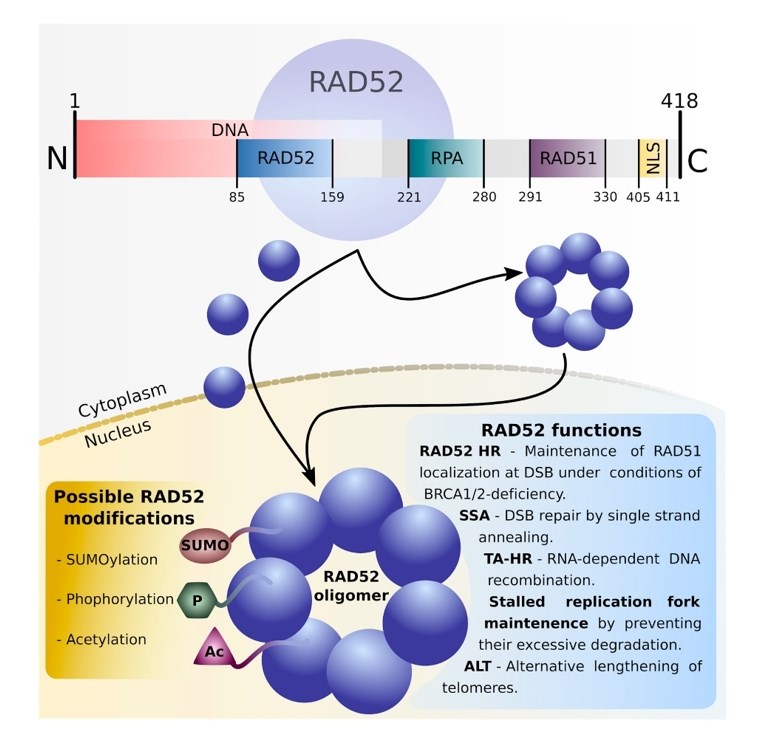What is RAD52 Protein
RAD52, officially known as "DNA repair and recombination protein RAD52," is a crucial player in the intricate world of molecular biology. Also recognized by its synonyms, including Recombination repair protein 2 and Yeast DNA repair gene 27, RAD52 belongs to the protein family associated with DNA repair and recombination. This family plays a pivotal role in maintaining the integrity of the genetic material within our cells.
RAD52 Protein Structural Characteristics and Classification
The RAD52 protein exhibits distinctive structural characteristics that define its functional role. Structurally, it is composed of conserved domains that enable its participation in critical cellular processes. The protein falls under the umbrella of recombinases, showcasing its prowess in DNA recombination. Recent research has delved into unraveling the intricate details of RAD52's structure, shedding light on its classification within the broader landscape of DNA repair proteins.
RAD52 Biological Functions and Molecular Mechanisms
At the heart of RAD52's significance lies its multifaceted biological functions. Primarily, RAD52 is recognized for its involvement in the homologous recombination repair pathway – a fundamental mechanism for the repair of DNA double-strand breaks. It acts as a molecular orchestrator, facilitating the exchange of genetic information between homologous DNA strands. Additionally, RAD52 contributes to the restart of stalled or collapsed DNA replication forks, ensuring the continuity of DNA synthesis.
The molecular mechanisms underlying RAD52's functions involve a meticulous dance of protein-protein interactions and nucleic acid binding. RAD52 forms oligomeric structures that are essential for its recombinase activity. Its ability to bind single-stranded DNA is a key element in mediating homologous recombination. Recent advances in research have elucidated the dynamic nature of RAD52's interactions, providing deeper insights into the cellular choreography orchestrated by this indispensable protein.

Figure 1. Human RAD52 structure, post-translational modifications, and functions. (Toma M, et al., 2019)
RAD52 Related Signaling Pathway
RAD52's involvement in DNA repair and recombination is intricately connected to specific cellular signaling pathways. It interacts with a network of proteins and participates in orchestrated cascades of molecular events. Understanding the signal pathways associated with RAD52 is crucial for unraveling the broader picture of cellular responses to DNA damage and replication stress.
RAD52 Related Diseases
Despite its pivotal role in DNA repair, RAD52's dysregulation or malfunction can contribute to various diseases. Aberrant RAD52 activity has been implicated in cancer development, as improper DNA repair mechanisms can lead to genomic instability. Research is ongoing to understand the specific molecular events that link RAD52 to cancer progression and to explore potential therapeutic interventions targeting RAD52-associated pathways.
RAD52's Applications in Biomedicine
RAD52's significance extends beyond the realm of basic research, finding practical applications in the field of biomedicine. In diagnostics development, RAD52 is being explored as a potential biomarker for identifying DNA repair deficiencies, aiding in the early detection of diseases with a genetic basis. Moreover, the protein's role in homologous recombination makes it a promising candidate for vaccine development, offering avenues to enhance the efficacy of DNA-based vaccines.
The therapeutic potential of RAD52 is a burgeoning area of research. Efforts are underway to develop targeted therapies that leverage RAD52's functions to selectively induce cell death in cancer cells. By exploiting the vulnerabilities associated with RAD52 dysregulation in cancer, researchers aim to design interventions that specifically target malignant cells while sparing healthy tissues.
Recommended Products
| Cat.# | Product name | Species | Source (Host) | Tag |
|---|---|---|---|---|
| RAD52-2667H | Recombinant Human RAD52 Homolog (S. Cerevisiae) | Human | E.coli | N/A |
| RAD52-135H | Recombinant Human RAD52 | Human | E.coli | N/A |
| RAD52-2668H | Recombinant Human RAD52, GST-tagged | Human | Wheat Germ | GST |
| RAD52-682H | Recombinant Human RAD52 Protein, MYC/DDK-tagged | Human | HEK293 | Myc/DDK |
| RAD52-301602H | Recombinant Human RAD52 protein, GST-tagged | Human | E.coli | GST |
| RAD52-1565HFL | Recombinant Full Length Human RAD52 Protein, C-Flag-tagged | Human | Mammalian cells | Flag |
| RAD52-4785H | Recombinant Human RAD52 Protein, Myc/DDK-tagged, C13 and N15-labeled | Human | HEK293T | Myc/DDK |
| RAD52-1852H | Recombinant Human RAD52 Protein, His (Fc)-Avi-tagged | Human | HEK293 | His (Fc)-Avi |
| RAD52-423HF | Recombinant Full Length Human RAD52 Protein, GST-tagged | Human | In Vitro Cell Free System | GST |
| RAD52-13875M | Recombinant Mouse RAD52 Protein | Human | Mammalian Cell | His |
Reference
- Toma M, et al. RAD52 as a potential target for synthetic lethality-based anticancer therapies. Cancers. 2019, 11(10): 1561.

